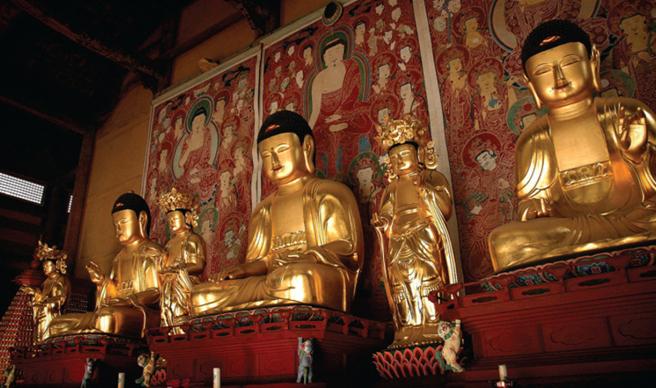
Editor’s note: “Teachings of Amitabha Buddha” is an inspiring column about the vital spiritual matters of Pure Land Buddhism – from its history, philosophy, and practice to its scriptures and their exegesis and interpretation. The column is penned by Alan Kwan, the founding editor of Buddhistdoor.com.
In the Commentary on the Contemplation Sutra, Master Shandao opened the door to the Pure Land based on the two teachings of two Buddhas. One is known as the Path of Importance expounded by Shakyamuni Buddha, and the other is the Path of Great Vow by Amitabha Buddha with his alternative intent. What are the differences between these two teachings in Pure Land Buddhism?
The teaching of Precepts, Meditation and Wisdom (Three Studies)
Master Shandao summarized all of Shakyamuni Buddha’s teachings into two main categories: meditative virtues and non-meditative virtues. Meditative virtues refers to Shakyamuni Buddha’s teachings of precepts, meditation and wisdom (known as the ‘Three Studies’), while non-meditative virtues are listed in detail in the Contemplation Sutra, known as ‘Three Virtues’ – virtues of human and heavenly beings, virtues of the Arhat practices and virtues of the Bodhisattva practices.
Upon enlightenment under the Bodhi tree, Shakyamuni Buddha said, “All sentient beings on Earth possess the quality of virtues and the wisdom of Tathagata. They cannot realize it only because of their ignorance and attachment.” There are many important meanings in this statement. Firstly, he declared that every sentient being has an equal potential to become a Buddha. Secondly, in the pursuit of Buddhahood, there are two main areas that people should work on. One is the quality of virtues, which is related to morality and compassion, and attained through non-meditative practices; and the other is related to wisdom, which is attained through meditative practices. Both practices are performed with one’s own effort, known as ‘self-power.’
To become a Buddha, we ordinary beings have to accomplish the first goal of liberating ourselves from the cycle of birth and death in this world. According to Shakyamuni Buddha, in order to have no more birth and death, one must clear two kinds of obstructions. The first kind is the Obstruction of Delusions, and the second is the Obstruction of Karma. Clearing the former involves the visualization of Nature and the elimination of the Delusion of Views in eighty-eight chapters by meditative practices. Whoever meets these requirements is qualified to achieve the first level of Four Fruitions in Arhatship, or the first level of 52 steps towards Buddhahood in Bodhisattva practices.
The latter involves the elimination of the Karmic Delusion of Volition in 81 chapters by non-meditative practices. One will then reach the final level of Four Fruitions in Arhatship, or the seventh level of 52 steps towards Buddhahood in Bodhisattva practices.
Master Yinguang, a great Pure Land patriarch in the Qing Dynasty said, “The teaching is called ‘Common Path’ if one practices precepts, meditation and wisdom through self power, in order to cut off delusion and karmic obstruction, and to realize the ultimate truth, thus to liberate oneself from the cycle of birth and death.
Unfortunately, this path is very complex. It is extremely difficult for ordinary beings to accomplish all these requirements nowadays, particularly because we lack proper guidance and direct supervision by a great teacher, like Shakyamuni Buddha. Under the influence of heavy karmic influence at the end of life, it is almost impossible to liberate ourselves from the cycle of birth and death with our limited capacity and effort (‘self-power’).
With great compassion, Shakyamuni Buddha told us that if we want to be liberated from the cycle of birth and death and continue to pursue the Buddhist Way, we have to switch to another path. We must be reborn in a radically different universe, the Land of Bliss. We have to sincerely dedicate all the merits and virtues (attained through meditative virtues and non-meditative virtues) to all beings, and generate sincere aspiration to be reborn in the Land of Bliss. This, revealed by Shakyamuni Buddha, is known as the Path of Importance in Pure Land Buddhism. This is the reason why dedication and aspiration, as discussed in the previous article, is necessary.
Teaching of Faith, Aspiration and Practice (Three ‘Sambhara’)
Amitabha Buddha has another approach to deliver sentient beings. He made 48 vows, considered thoroughly and planned in detail, so as to provide all beings in the cosmos a simple and easy way to liberate them from the cycle of birth and death, and to expedite the completion of Buddhahood once they are reborn in the Land of Bliss. He finally became Amitabha Buddha after five kalpas, and accomplished all his vows, including the 18th vow, which is of utmost importance.
As the 18th vow is the foundation of the Path of Great Vow in Pure Land Buddhism, it is called the Fundamental Vow. It states: “If, when I achieve Buddhahood, sentient beings of the ten directions who sincerely and joyfully entrust themselves to me, wish to be reborn in my land and recite my name, even ten times, should fail to be born there, may I not attain perfect enlightenment. Excepted are those who commit the five gravest transgressions or slander the correct Dharma.”
Referring to the Fundamental Vow, Amitabha Buddha asks us to entrust in him (faith), wish to be reborn in his paradise (aspiration) and recite his name (practice). Then, he will honor his promise and deliver us to be reborn in his Pure Land. His teaching revolves around three main aspects: faith, aspiration and practice. It is known as the ‘Three Sambhara’ or ‘Three Essentials’, which, like a tripod, are necessary and sufficient requirements for rebirth in the Pure Land.
Having made the vows, he continues to accumulate the pure and flawless merits and virtues through the practice of the Three Studies, the Six Paramitas and other Bodhisattva practices over inconceivable and countless kalpas. These merits and virtues are necessary for our rebirth in the Pure Land, because our impure and flawed merits and virtues accumulated in the Saha World are insignificant. As the two kinds of merits and virtues are incompatible, Amitabha Buddha has no interest or use for our merits and virtues attained in this world. Thus, we should know that the entire teaching of Amitabha Buddha is based on ‘other-power.’ No merits or virtues generated by self-power are taken into account.
Master Yinguang defined Pure Land Buddhism as follows: Alternatively, the teaching is called ‘Particular Path’, if one possesses true faith and strong aspiration, and holdfasts in Amitabha-recitation, in order to be reborn with the aid of Buddha’s compassionate power.”
An illustration of ‘self-power’ and ‘other-power’, by Master Tanluan
The concept of ‘self-power’ and ‘other-power’ was firstly introduced by Master Tanluan (476 – 542 AD) who wrote the Commentary on the Treatise on Rebirth in the Pure Land. He illustrated these two concepts with an example at the end of his book. He said, “I will show you an example to illustrate what the self-power and other-power is. If a person who is scared to fall into the Three Wretched Realms, he holds the precepts. By holding precepts, he practices meditation. Because of meditation, he achieves the paranormal power. With paranormal power, he can travel freely in the continents in the four directions. That is known as ‘self-power.’

He continued,“Conversely, for an inferior traveler, he is so inferior that he cannot even ride on an ass. However, he follows the flying king with turning wheels. He then travels in the continents in the four directions without any difficulty or obstruction. That is known as ‘other-power.’ Don’t be stupid! The future learners and practitioners who hear of obtainable ‘other-power’ should believe it. Don’t restrict yourself and just take a part of it.”In expounding his teaching, Shakyamuni Buddha takes a casual ground approach, which aims at clearing all kinds of obstructions and delusions. The scope of his teaching is mainly the Three Studies (Precepts, Meditation and Wisdom), which involves meditative and non-meditative virtues by ‘self-power.’ Alternatively, Amitabha Buddha takes a ‘reward ground’ approach, which aims at delivering sentient beings to his Pure Land. The scope of his teaching is mainly ‘Three Sambhara’ or ‘Three Essentials’ (faith, aspiration and practice) by ‘other-power.’






